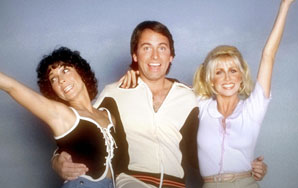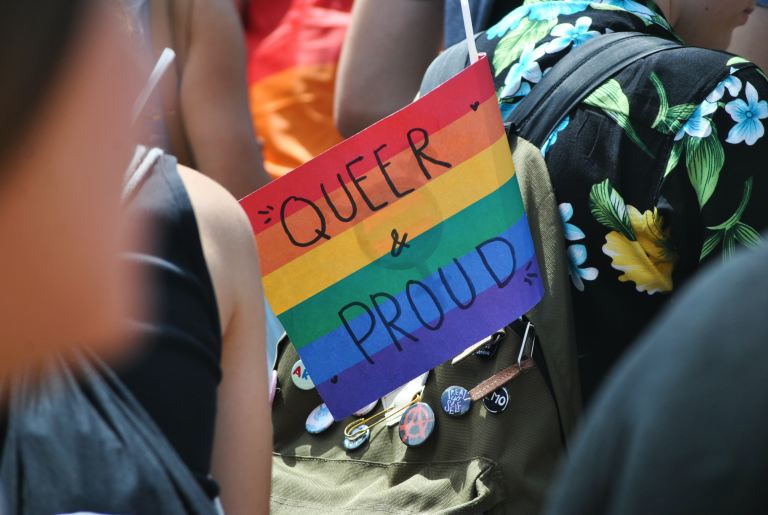Monogam-ish: Two Is Company, But Is Three Really A Crowd?
Is monogamy not real or are my friends just a little promiscuous? Let's look at some data.


Most days when I think about dating and relationships, especially when talking with friends, I always come to the same conclusion: Monogamy isn’t real.
In the gay world, I feel that no matter how committed a couple is when I meet them, or how beautiful their life is together, or even, how perfect they seem, there always seem to be infidelity hiding behind those 1000-count sheets. The countless dinner parties, nights at bars, Pride events, and everything in between keep proving one thing to me over and over again that most men seem not to really be interested in just one person, but rather lots of different people.
At first, I came to really resent this aspect of the ‘gay lifestyle,’ as many call it. Growing up I was always bombarded with images of gay men as hypersexual and really promiscuous. From TV shows like Will & Grace with Jack’s countless partners to Queer as Folk with Brian’s countless partners to… well you get the point, gay men were constantly shoved into the light of always looking for the next great fuck. I always found myself really disheartened by this image, because growing up I found myself wanting the traditional life of one marriage and some kids. Not a life where I was constantly in clubs and in the beds of men whose names I don’t know.
I was at brunch the other day with a group of friends and the topic of monogamy came up after one friend shared some difficulties he is having with his partner, who recently stepped out of their relationship. The older gay men around the table began to laugh, while also comforting him, and suggested for him to just wait. Once he gets older he will understand, ‘we’ as gay men just can’t really be monogamous. They weren’t arguing that it isn’t possible, because there are those rare birds that have never cheated in any way, but what they were suggesting that: Monogamy may be too big of a cross to carry, that we all will have moments of lust or desire and engaging in other activities with folks outside of your relationship doesn’t mean you love your partner any less.
So, is monogamy not real or are my friends just a little promiscuous? Let’s look at some data.
Dr. Jeffrey T. Parsons, director of Hunter College’s Center for HIV Educational Studies and Training (CHEST) worked with a team of researchers to investigate a relatively unexplored area of social research, by surveying over 800 gay and bisexual men in the New York City area. They were interested in exploring the variations of ‘monogamy’ and ‘commitment’ within gay and bisexual men living in New York City. According to a blog post on the Center’s site, Dr. Parsons pointed out that “the diversity in types of non-monogamous relationships was interesting, and something that hasn’t been explored very much in research studies. Typically gay men have been categorized as monogamous or not, and our data shows that it is not so black and white.”
CHEST’s survey indicated that about 60% were single. Of those partnered, about 58% were in monogamous relationships. Of those that were non-monogamous, 53% were in open relationships, and 47% were in “monogamish” relationships (i.e., couples that have sex with others as a couple such as “three-ways” or group sex). From CHEST’s data, we are seeing evidence that Dr. Parson’s may be right; it’s not so black and white.
These findings by CHEST are not the first, and New York City gay folks aren’t an anomaly with these behaviors. Back in 2010, researchers at San Francisco State University did a similar study, also revealing just how common open relationships are among gay men and lesbians in the Bay Area. The Gay Couples Study followed 556 male couples for three years — about 50 percent of those surveyed have sex outside their relationships, with the knowledge and approval of their partners, giving us really similar numbers to CHEST’s data.
Now I know what you are thinking: These can’t possibly be happy, healthy relationships, right?
From the survey data, CHEST found that men in fully monogamous partnerships showed significantly less illicit drug use and significantly reduced sexual health risk when compared to all other groups of men (single, open, and “monogamish”), suggesting a benefit to monogamy. But CHEST’s findings also indicate that non-monogamous partnerships provide other types of benefits to gay and bisexual men. Men in “monogamish” relationships indicated lower rates of depression and higher life satisfaction when compared to single gay men. Dr. Parsons adds, “Our findings suggest that certain types of non-monogamous relationships — especially ‘monogamish’ ones — are actually beneficial to gay men, contrary to assumptions that monogamous relationships are always somehow inherently better.”
So, being in a monogamish relationship means you may have higher drug use and sexual health risks, but you may actually be happier, as a person? Easy enough, right?
Not really. It’s a little more complicated.
Individuals in these relationships usually don’t just one day spout out, “Honey, just go out, have fun, do whatever you like!” There is a lot boundary setting and a lot more talking before these types of relationships happen and are successful.
The Advocate recently put together a great guide to ‘non-monogamy’ that gives on basic questions and things to think through before opening up one’s relationship. Questions that answer the who’s, what’s, when’s, what’s, and where’s to breaking the mold. This I think would be a great starting point for any couple thinking about opening the doors of their relationship.
So, monogamish works it seems, but is this only for LGBTQ folks? Dan Savage thinks not and is working to open this conversation even more to include heterosexual folks. Earlier this year, Savage dedicated a spot in his popular column, Savage Love, to monogamish heterosexual couples to tell their stories of success with not participating in traditional monogamy, with rumors to even write a book on the subject.
In the article by Mark Oppenheimer, “Married, With Infidelities,” Savage shares that, “I acknowledge the advantages of monogamy…when it comes to sexual safety, infections, emotional safety, paternity assurances. But people in monogamous relationships have to be willing to meet me a quarter of the way and acknowledge the drawbacks of monogamy around boredom, despair, lack of variety, sexual death and being taken for granted.”
And I agree with Savage, monogamous folks need to come forward and speak up more about how tough it is to be with just one person forever.
Beyond Savage, there have been other great arguments like: men may be physically incapable of fidelity because polygamy is a biological imperative to ensure survival of the male gene. Or arguments from people like Joe Quirk, author of the best-selling relationship book “It’s Not You, It’s Biology” telling the New York Times that, “In 1900, the average life span for a U.S. citizen was 47. Now we’re living so much longer, ‘until death do us part’ is twice as challenging.”
All this can be — and probably is — worrisome to marriage advocates as the battle for marriage equity continues and many fight for a traditional life, or at least options, like heterosexual folks. But should we see monogamish as a threat to marriage? I think not.
If we are finding out that people are actually happier when openly and frankly discussing their desires, passions, what they need from each other — even if that means another partner a few nights a month — then won’t that in turn help marriages? Currently, divorce rates sit at a nice 50% rate for couples in America, and only climbs as people experience more divorces in their life. We are seeing that even without gays getting married, the sanctity of it is being challenged without our help.
Marriage, I would argue, is in great need of an intervention or in the least some expansion in how we understand it, because it’s not working that well anymore.
By us expanding our definitions and ideals around how we believe two people should be together, and maybe throwing away that old saying, “two’s company, but three’s a crowd,” and instead welcoming a crowd, we may in turn actually make ourselves happier and have longer, healthier relationships, even if they are monogamish.
As for my friend having relationships problems, those will probably continue as he and his partner try to figure out what is next. Approaching questions like: Do we want to open the relationship up? Can we forgive and forget this one instance? Does cheating mean we aren’t in love? But some of these questions are questions everyone should ask their partner(s.) And we shouldn’t worry about the fact that our partner has come to us with these questions, but rather, worry about how we both answer them.
The answer to these questions may challenge and potentially change our relationships, and in turn force some of us to realize that our relationship is not as good as it could be. These questions make us learn new things about ourselves. And with some of us, the answer we receive may have us realizing that in the end, all the Disney movies may be wrong. We realize Prince Charming may not charming forever and we may find ourselves waking up one day wanting to invite Aladdin or Prince Eric or Prince Phillip to join us in our bed, maybe just a few times a month. And in these moments, when our relationship is not monogamous but more monogamish, we are happy. And most dangerously: we may find that monogamy isn’t what we have wanted all along. ![]()




